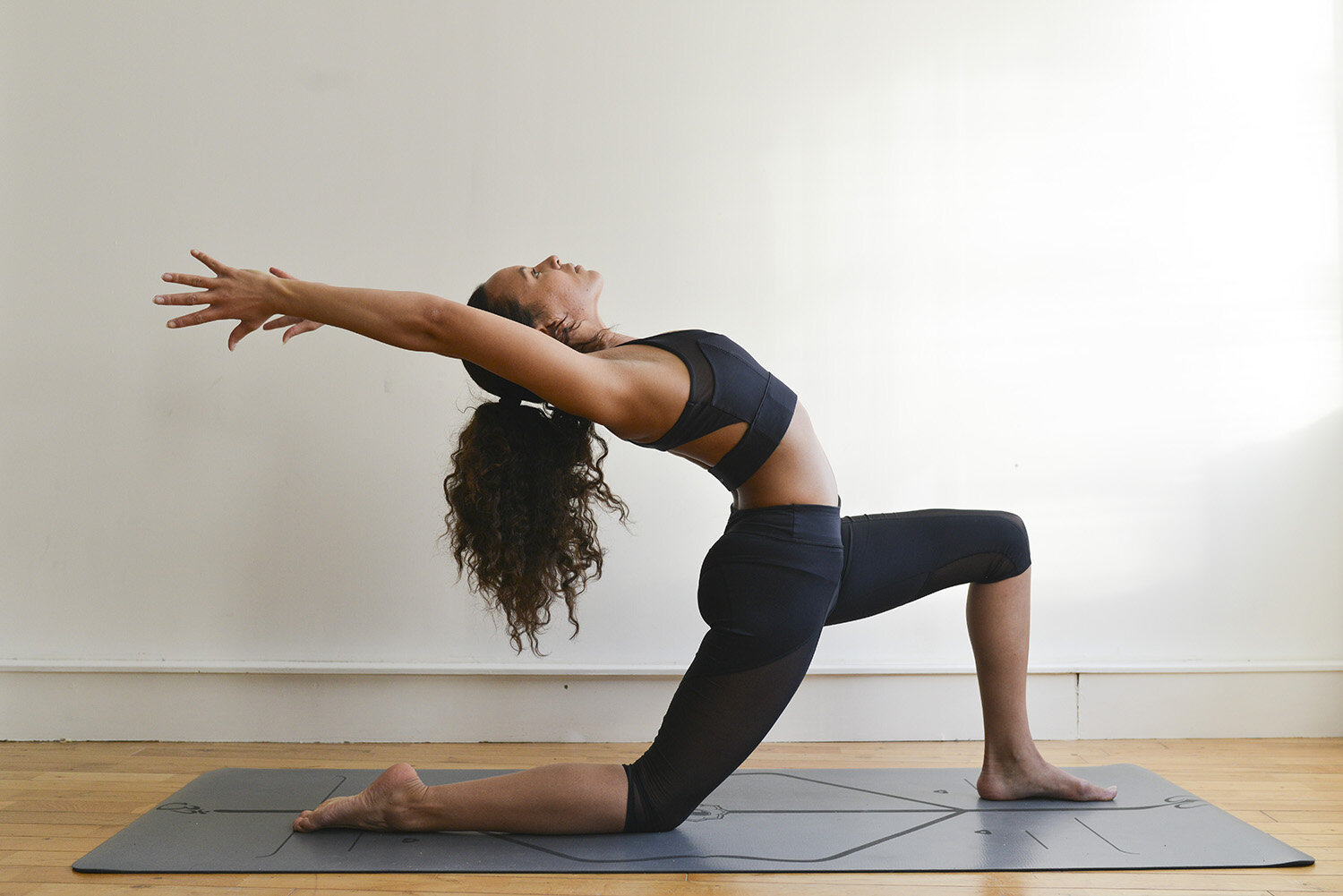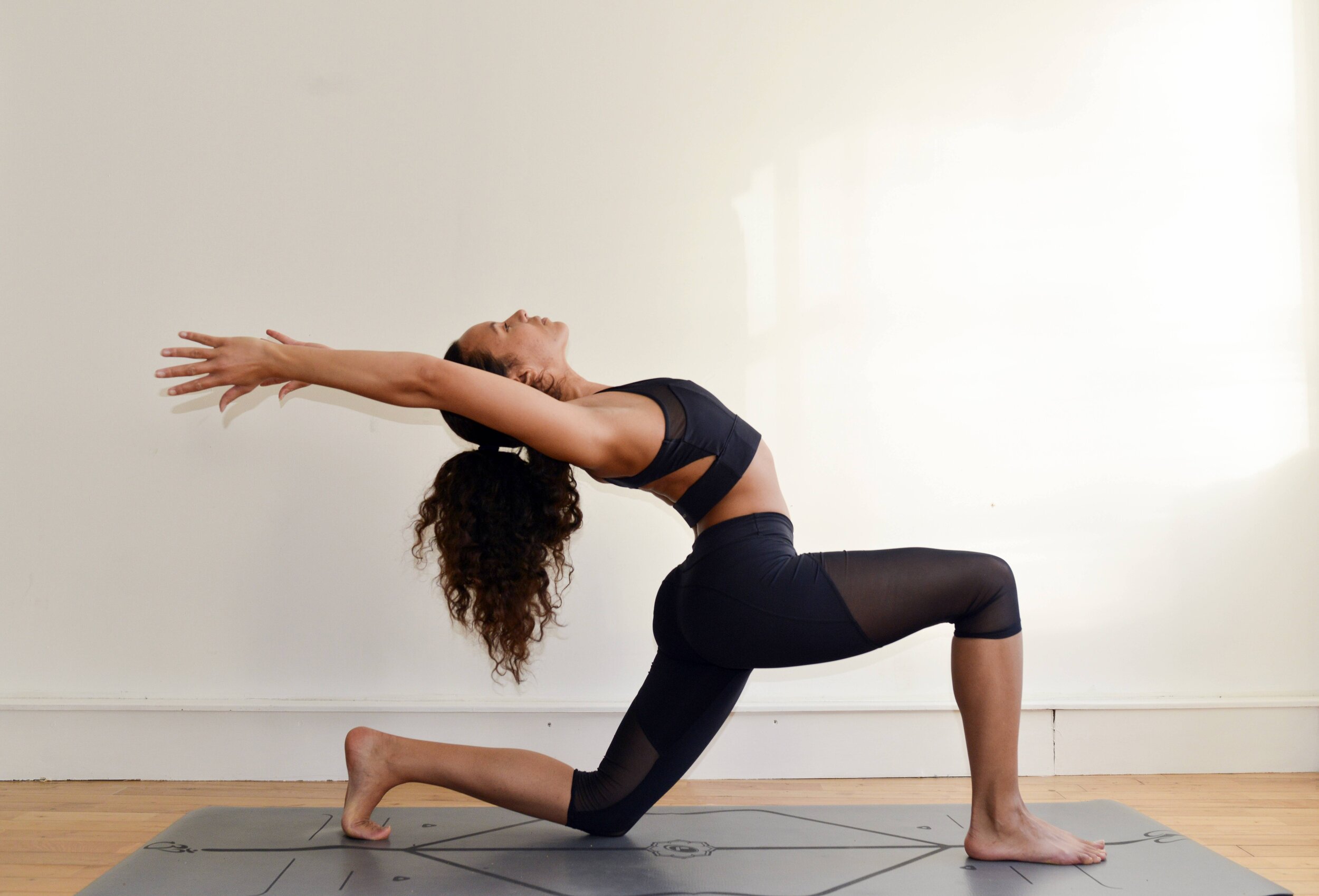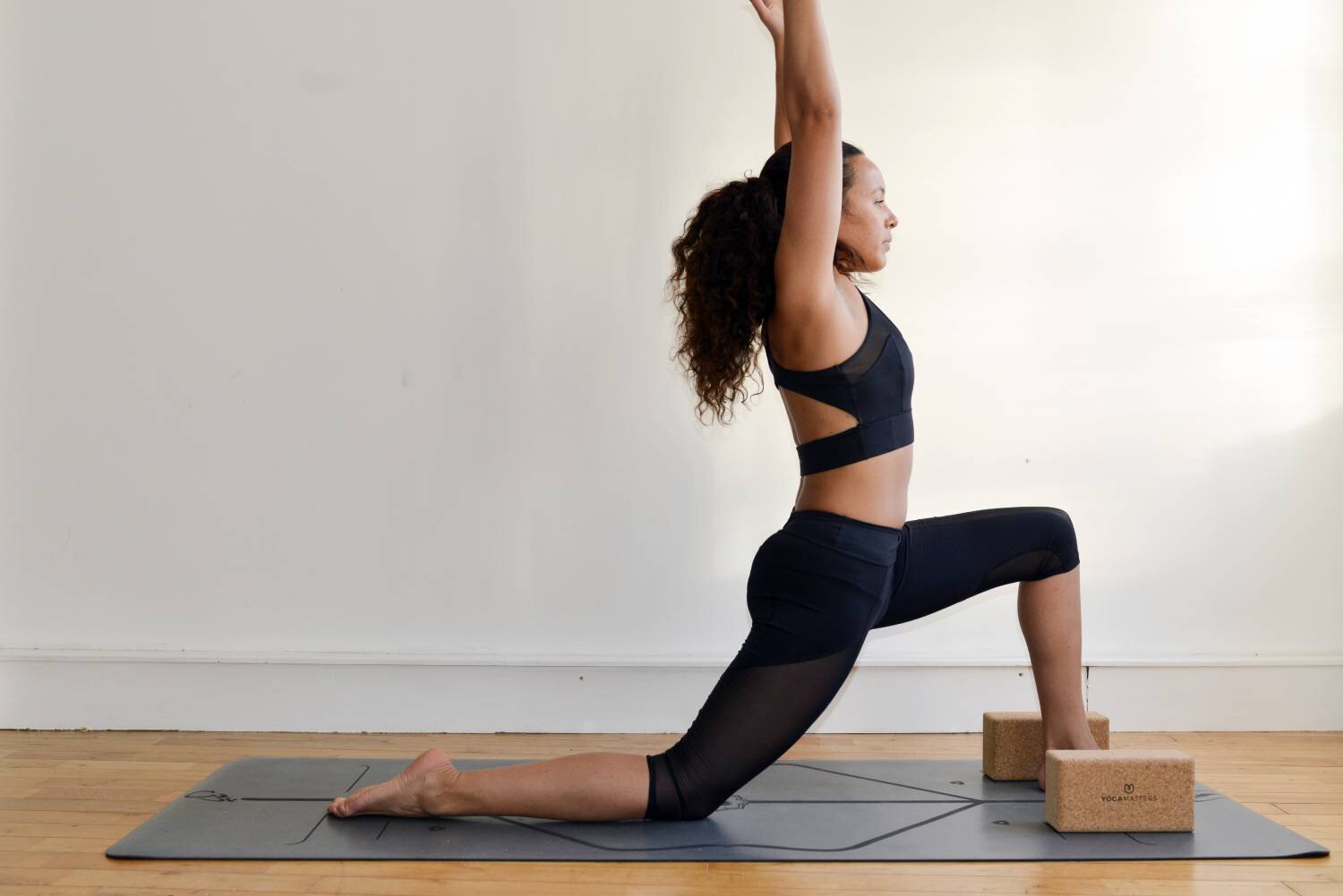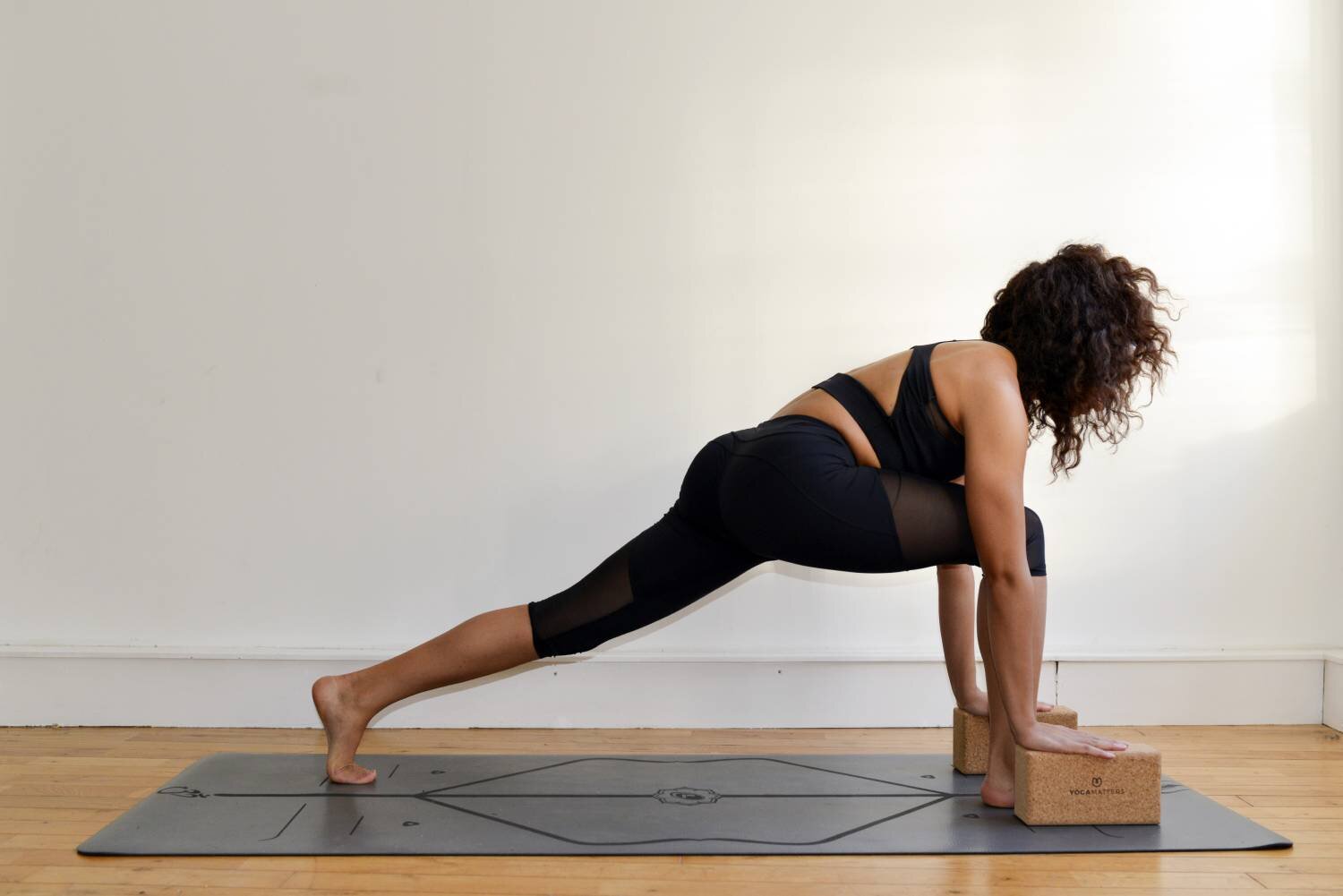Yoga Tips & Tricks: Reach for the Sky in Crescent Lunge
Ashley Bailey in Crescent Lunge / Low Lunge (Anjaneyasana), by Heather Elton.
As a beginner, starting something new can seem daunting and sticking with it when you are struggling can only add to the challenge. So, I decided to create a series of tips and tricks to help you find your strength and ease in some of the foundational yoga poses. These tips are not only for class but can also be practiced at home.
Some of the most common poses you will find in most Hatha or (Hatha based*) yoga classes are:
Childs Pose (Balasana)
Easy Pose (Sukhasana)
Corpse Pose (Savasana)
In the third edition of our Yoga Tips & Tricks series we are looking at Crescent Lunge (Anjaneyasana), also known as High Lunge, Low Lunge and Runners Lunge.
In yoga, asanas (postures) are grouped according to their primary function and influence on the body: standing, balancing, seated, backbends, forward folds, spinal twists, inversions, supine and meditation postures. Some of these groups also cross over to create variations and modifications of postures.
A lunge is a standing posture. After our feet (our roots), strong legs are the foundation of our standing postures. I’m a great advocate for combining strength with flexibility (aka mobility). This is important not only from a wholistic point of view but also to prevent injury as we move supporting our own body weight. Anjaneyasana teaches us to tune into our core stability and to focus as we practice transitioning in and out of the posture with strength and grace.
Anjaneyasana is often used as a warm up posture as it prepares the whole body for more challenging postures or flow sequences. It can be practiced independently and within a sun salutation. It is a good allrounder hence why I have included it in this list and why it can be found in most yoga classes. It can even be practiced using a chair for those with limited mobility and or challenged by balance.
We need strength and stability to move through the world with grace, both physically and mentally.
Feeling balanced physically has a proven effect on our mental health. Balance can’t be taken for granted and must be maintained as we get older. If we loose our balance or miss a step, it’s our muscle power that stabilises us. For seniors in particular practicing exercises and postures that maintain and strengthen their stabiliser muscles and improve balance can help prevent falls.
As I mentioned in last month’s blog post on Mountain Pose (Tadasana), “When we are in a bad place mentally it has an effect on the way we hold ourselves.” We need strength and stability to move through the world with grace, both physically and mentally. It helps us to re-cover when we get knocked off centre by the world and the people around us.
I experienced this personally when I injured my hamstrings and my knees became less stable. Suddenly muscles I hadn’t heard from in a while came out to compensate for my wobbliness. Most worrying though was the effect it had on me mentally. I literally felt more wobbly emotionally as I became more cautious walking about in the world.
Notice the next time you’re feeling a little wobbly on your feet, on or off the mat. How it makes you feel in other ways, physically or emotionally. Or perhaps the other way around, notice how it impacts your sense of physical strength and stability when you are feeling unsteady emotionally.
The next time you feel a little unstable, try firming your feet to the ground and engaging your legs in a “power pose” or doing a few lunges to get blood flowing to the legs. When our legs feel strong, it can help us to feel more grounded.
Hanuman carrying the the fabled Medicine Mountain. Vintage Authentic Raja Ravi Varma Lithograph. Date unknown.
A little History
Many postures have a story or philosophy behind them. Anjaneyasana refers to the mother of Hanuman, the monkey god, sometimes referred to as Lord Anjaneya. His mother’s name was Anjani. The pose resembles the young Anjaneya, reaching towards the sky and the warmth of the sun. Hanuman is known for leaping to the rescue in a number of stories in the Hindu epic, the Ramayana. He is also associated with the Front Splits (Hanumanasana) for which Anjaneyasana is a good preparatory pose.
Anjaneyasana / Crescent Lunge: Step-by-Step Instructions
Step 1: From downward facing dog (Adho Mukha Svanasana), on an exhale step your right foot between your hands. Or, from a standing forward fold pose (Uttanasana) step your left foot back.
Step 2: Align your right knee above your right ankle so that your shin is vertical. Lower your back knee to the ground and turn the top of our foot to the floor.
Step 3: Inhale to lift your torso upright and your arms over head, fingertips reaching towards the ceiling. Lift your sternum (breast bone) straight up. As you do this keep your front ribs from popping forward by drawing them back into the body.
Step 4: Roll your shoulders back and draw your shoulder blades down toward your waist.
Step 5: Stay in the pose for 30 seconds to 1 minute, breathing easily.
Step 6: On an exhale lower your arms, bringing your hands back down to the ground and step back to downward facing dog or forward to standing forward fold. Repeat on the others side for the same length of time.
Tips & Tricks
Check your alignment: Knees & Hips: Pay attention to the position of the front knee above your ankle. Notice if your knee drops in or out and try to keep it centred in line with your hip. Your back leg should also be in line with the hip on that side. This posture has forward facing hips, so both hips are facing the front of the mat.
The Backbend: Keep your arms in line with your ears as you lean back, lifting your sternum towards the ceiling. Pay attention not to let your head drop back but try to keep the crown of your head in line with the top of your spine. See also below variations.Other Variations / Progressions: Crescent lunge is a good preparatory pose for Warrior I (Virabhadrasana I). It can be a good alternative for those who experience knee discomfort in Warrior I as a result of injury or health conditions.
High Lunge: To come into high lunge, tuck your back toes and raise your knee away from the floor. Stack your back heel above your ankle. Keep the back leg active by gently pressing the heel away from you.
To challenge your balance further, try the poses with the eyes closed.
Modifications: If raising the arms overhead is uncomfortable, keep your hands on your front thigh, hips or blocks. If looking up is uncomfortable, keep your head and gaze straight forward or slightly downward. See also “Use Props” below.
Variations that can be performed in either low or high crescent lunge:
The Backbend: Keeping the arms in line with the ears and maintaining length through the spine (no compression), begin to take your shoulders back and reach your finger tips back behind you. Only go back so far as you can move in and out with control.
The Twist: Paying attention to keep both hips facing forward twist your upper body towards your front thigh. Arms can come out to the side, spending the shoulders and broadening across the chest. Or palms can come together in Anjali mudra.
Other variations: Bound Crescent Low Lunge (Buddha Anjaneyasana)
Arm Variations: Eagle arms, Anjali mudra at heart centre, arms in line with ears, hands on hips hands on your front knee, on the floor or blocks.Use props: Humility can be an excellent teacher and so can props. They can help us become more aware of our body’s alignment and adapt our practice when we’re working with injuries, disabilities or health conditions.
If you experience discomfort in your back knee in Low Lunge first try to tip your knee cap toward the back of your mat so you are resting on the top of your thigh than the knee. If this isn’t enough or doesn’t help try doubling up your mat, using a mat pad, blanket, cushion or block under your knee.
If your hands or fingertips don’t comfortably reach the ground in the Low Lunge variation with hands down, use blocks under your hands. If you don’t have blocks you can use rolled up towels or books.
Using a chair (three ways):
The first way. Seated Low Lunge. Sitting in a chair, on an inhale raise both arms and your right knee. Hold here for a few breaths then on an exhale lower your arms and leg. Repeat on the other side. You can also practice this with hands holding the raised knee or the sides of the chair.
The second way. From a forward facing seated position on the chair, swivel to the right until your right thigh rests on the chair seat and your left leg hangs down freely down in front of the seat. Hold on to the back or seat of the chair for balance. Slide your left leg back until your leg is as straight as is comfortable for you, without locking out the knee. Stack your left toes under your ankle. Both legs should be in line with your hips with both hips pointing forward. If your right foot doesn’t reach the ground, place something underneath it, like a block, book or rolled up towel or blanket. Raise your left arm up in line with your shoulder or ear. Roll your shoulders back and lift your rib cage away from your hips. If you feel balanced here you can try raising both arms up towards the ceiling. Repeat on the other side.
The third way. Stand in tadasana behind your chair. Place your hands on the back of the chair and step your left foot back, stacking your right knee above your right ankle. Check that your right shin is vertical. Slide your left leg back until your leg is as straight as is comfortable for you, without locking out the knee. Stack your left toes under your ankle. Both legs should be in line with your hips with both hips pointing forward. If you feel balanced here you can try raising one the the other or both arms up towards the ceiling. Repeat on the other side.Check you out! There is no shame in taking a look at yourself in the mirror. It can be a great way to see the natural alignment of our bodies in a posture. Does your knee go beyond your ankle? Do your hips drop heavily towards the floor rather than lifting up? Do your front lower ribs pop forward when you move into the backbend? What effect does each micro adjustment you make have on the rest of your body and the posture?
Anjaneyasana Benefits
Strengthens the hips, glutes, thighs and feet.
Stretches the hip flexors, quads and shoulders.
Expands the chest and lungs.
Contraindications (don’t do this if…)
Always check with your health care professional if you have a health condition, injury, are pregnant or are concerned about the impact of yoga on your health.
Raised arms and the deep stretch of the chest are may not suit those with high blood pressure.
If you have a knee or hip injury or injury to the quads or hamstrings, this posture can put pressure on this.
It’s advised that those with weak body balance should use supports such as a chair, a wall or knee supports.
I hope you’ve found these tips useful. Keep an eye out for the next post in the series where we will be taking a look at an all time favourite Childs Pose (Balasana).
* All of the following are styles of Hatha Yoga: Ashtanga, Anusara, Bikram, Jivamukti, Kripalu, Kundalini, Iyengar, Sivananda and Viniyoga.






